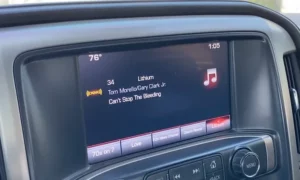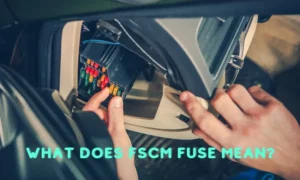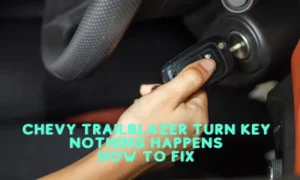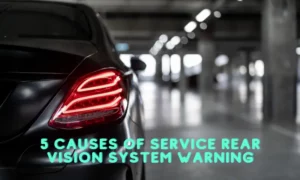One of the common problems of any model of the Chevrolet brand is a voltage charging system error. Professionals have tried to suggest what could cause the problem and what remedy to apply. The truth is, this is not an issue you can ignore as a car owner. It requires an instant fix. Otherwise, if it lingers on, you may experience more severe damage to various parts of the car.
But what is the best fix for the service high voltage charging system” error on Chevy Volt? Let’s find out in this short article.
What is the High Voltage Charging System?
The Chevy charging system houses the ECU, alternator, battery, level sensor, and wires. Whenever any of these is faulty, there’s a potential risk already on the entire charging system. Whenever this message pops up, the voltage or amperage is working with the heat engine. Typically, the volt should allow the load.
The diagnostic trouble code for the service high voltage charging system fault is P2504. This code comes with several symptoms apart from the error message you receive. I’ll come to this in detail later.
Why is the High Voltage Charging System error and What is the Fix?
There are several reasons you’ll see the high voltage charging system error. Here are the common causes.
Faulty coolant level sensor
A common reason you’ll receive the high voltage charging system error in your Chevy truck is a faulty conditioning liquid level sensor. Typically, the coolant level sensor is installed in a vehicle to detect how much coolant fluid is in the coolant system. It can detect the absence or presence of essential coolant fluid in your high-voltage battery. In addition, the coolant level sensor ensures the proper operation of critical parts of the vehicle. It features a 5v wire.
What’s the fix? The thing to do with a failing coolant level sensor is to replace it. You cannot this part of the charging system. Apart from enabling the uptime of the critical components of the system, the sensor also extends its lifespan. These parts cannot work well without a healthy sensor.
When troubleshooting the solution for a defective coolant sensor, make sure you disconnect the 12-volt battery and let the car be in standby. Start by opening your car trunk and wait for about 20 minutes to put your car in standby mode.
An opening of the wiring harness
An issue with the wiring harness is a major trigger of the high voltage charging system error. The wiring harness can become faulty and start failing if there’s an opening on the wiring harness. Sometimes you have replaced the coolant level sensor. Yet, the error message refuses to disappear. You may need to check if any of the wires have opened.
What’s the fix? Fixing an open wire simply requires you to wrap electrical tape over the exposed area of the wire and stick it. You should wrap 1 full revolution of the peeled tape around the exposed area of the wire. Press it down gently but firmly to make it stick.
Loosened Wires from Lugs
Apart from the opening in the wires, it may also be that the wires have loosened from the lugs that connect to the coolant sensor. Other possible wiring issues include short circuiting, wire melting, blown fuse, or melted insulation. To check this broken wire, what you need to do is to test if 5volt is present in the coolant sensor. Anything lower than 5v means that you have a broken wire
What is the fix? You can also use tape, but first remove the cover tape. You may need to tighten any loose screw terminals. This way you can reconnect the wire to its terminals.
Low Battery Coolant level
OnceyourChevypops up the high voltage charging system, you should check the battery coolant level. There’s a chance that the conditioning liquid of the high-voltage battery is far below the normal level.
What’s the fix? All you need to do is to refill the coolant reservoir. Make sure the conditioning liquid is pretty well above the seam. You need the vacuum technique to get the coolant refilled.
FAQs
Will installing a defeat plug sensor Fix the Service High Voltage Charging System fault?
Yes, if all fixes above fail, you can install a sensor defeat device. This design helps disable, obstruct, or interfere with emission controls. I will recommend using a 24kohm resistor, depending on your Chevy model.
When you disconnect the coolant sensor from the reservoir, you may notice an intermittent opening as you shove it. Alternatively, you can make a two-series resistor of 10kohm and 4.5kohm and put it across the plug. This will temporarily clear the error code.
What’s cost of diagnosing the Service High Voltage Charging System code?
How much you’ll spend diagnosing the P2504 trouble code depends on what causes the error in the first place. As you’ve learnt, there are several reasons the service high voltage charging system fault comes up. Regardless of the reason, you’ll spend up to $120 for a diagnosis.
What are the Symptoms of the Service High Voltage Charging System?
You’ll notice the following symptoms if the P2504 code comes on. These signs are aside the illuminating check engine light.
- Red battery light comes on the dash
- Low fuel economy
- Engine stalling when it’s idle
- Automatic transmission suffers irregular shifting
Final Thoughts
Let me reiterate that the service high voltage charging system error message requires urgent attention. In the end, you need you. I hope you find this article helpful. So, when next this kind of message pops up, you can handle it. Before taking any step, however, make sure you run a scan on your car. This way, you can be sure of the error codes to know the appropriate fix to apply.







